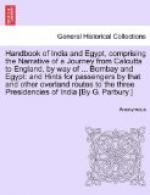for three days in the agony of death, or Othman, the
third Khalifa, who died of thirst, or “the Lion
of God,” whose life came to so disastrous a
close. But the Shia, while admitting that the
death of the first martyrs may have wrought severer
loss to Islam, cannot admit that their end surpasses
in pathos the tale of the bitter tenth of Mohurrum
when the stars quivered in a bloodied sky and the
very walls of the palace of Kufa rained tears of blood
as the head of the Martyr was borne before them.
He cannot also approve the Sunni practice of converting
a season of mourning into one of revelry and brawl,
for he does not realize the influence of the local
Hindu element upon the Mohurrum and cannot comprehend
that the Indian additions to the festival have their
roots in the deep soil of Hindu spirit-belief.
For to the Hindu, and to the Sunni Mahomedan who has
borrowed somewhat from him, all seasons of death and
mourning act as a lode-stone to the unhoused and naked
spirits who are ever wandering through the silent
spaces of the East. Some of these spirits we
can appease or coax into becoming guardian-angels by
housing them in handsome cenotaphs; others we can
lodge in the horse-shoe or in that great spirit-house,
the tiger, letting them sport for a day or two in the
bodies of our men and youths, who are adorned with
yellow stripes symbolical of their role; while other
more malevolent spirits can only be driven away by
shouting, buffeting and drumming, such as characterize
the Mohurrum season in Bombay. The Indian element
of nervous excitement might in course of ages have
been sobered by the puritanism of Islam but for the
presence of the African, who unites with a firm belief
in spirits a phenomenal desire for noise and brawling;
and it is the union of this jovial African element
with the sentimentality of Persia and the spirit-worship
of pure Hinduism which renders the Bombay Mohurrum
more lively and more varied than any Mahomedan celebration
in Cairo, Damascus or Constantinople.
Although the regular Mohurrum ceremonies do not commence
until the fifth day of the Mohurrum moon, the Mahomedan
quarters of the city are astir on the first of the
month. From morn till eve the streets are filled
with bands of boys, and sometimes girls, blowing raucous
blasts on hollow bamboos, which are adorned with a
tin ‘panja,’ the sacred open hand emblematical
of the Prophet, his daughter Fatima, her husband Ali
and their two martyred sons. The sacred five,
in the form of the outstretched hand, adorn nearly
all Mohurrum symbols, from the toy trumpet and the
top of the banner-pole to the horseshoe rod of the
devotee and the ‘tazia’ or domed bier.
Youths, preceded by drummers and clarionet-players,
wander through the streets laying all the shop-keepers
under contribution for subscriptions; the well-to-do
householder sets to building a ‘sabil’
or charity-fountain in one corner of his verandah
or on a site somewhat removed from the fairway of
traffic; while a continuous stream of people afflicted




